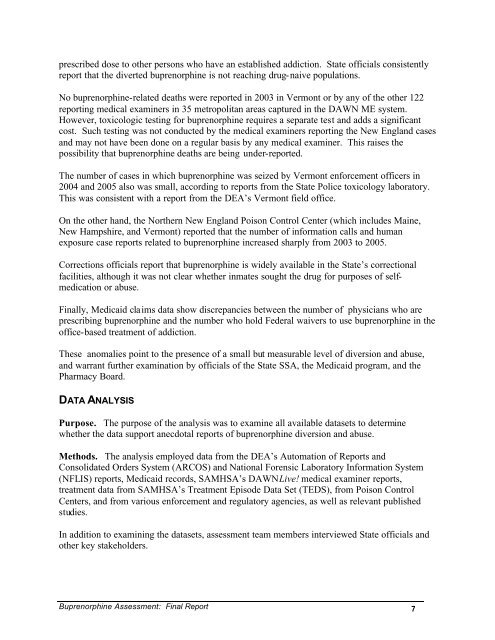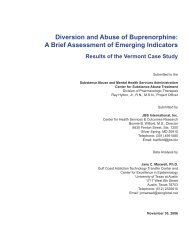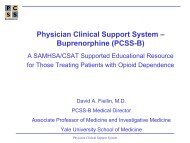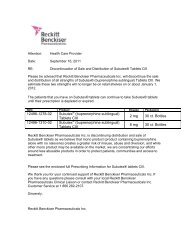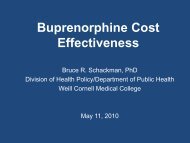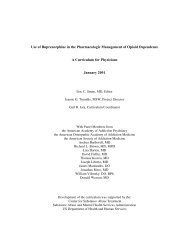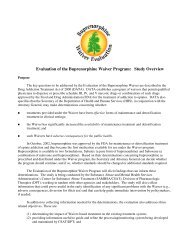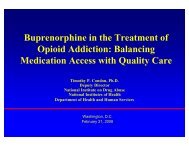Diversion and Abuse of Buprenorphine
Diversion and Abuse of Buprenorphine
Diversion and Abuse of Buprenorphine
You also want an ePaper? Increase the reach of your titles
YUMPU automatically turns print PDFs into web optimized ePapers that Google loves.
prescribed dose to other persons who have an established addiction. State <strong>of</strong>ficials consistently<br />
report that the diverted buprenorphine is not reaching drug-naive populations.<br />
No buprenorphine-related deaths were reported in 2003 in Vermont or by any <strong>of</strong> the other 122<br />
reporting medical examiners in 35 metropolitan areas captured in the DAWN ME system.<br />
However, toxicologic testing for buprenorphine requires a separate test <strong>and</strong> adds a significant<br />
cost. Such testing was not conducted by the medical examiners reporting the New Engl<strong>and</strong> cases<br />
<strong>and</strong> may not have been done on a regular basis by any medical examiner. This raises the<br />
possibility that buprenorphine deaths are being under-reported.<br />
The number <strong>of</strong> cases in which buprenorphine was seized by Vermont enforcement <strong>of</strong>ficers in<br />
2004 <strong>and</strong> 2005 also was small, according to reports from the State Police toxicology laboratory.<br />
This was consistent with a report from the DEA’s Vermont field <strong>of</strong>fice.<br />
On the other h<strong>and</strong>, the Northern New Engl<strong>and</strong> Poison Control Center (which includes Maine,<br />
New Hampshire, <strong>and</strong> Vermont) reported that the number <strong>of</strong> information calls <strong>and</strong> human<br />
exposure case reports related to buprenorphine increased sharply from 2003 to 2005.<br />
Corrections <strong>of</strong>ficials report that buprenorphine is widely available in the State’s correctional<br />
facilities, although it was not clear whether inmates sought the drug for purposes <strong>of</strong> selfmedication<br />
or abuse.<br />
Finally, Medicaid claims data show discrepancies between the number <strong>of</strong> physicians who are<br />
prescribing buprenorphine <strong>and</strong> the number who hold Federal waivers to use buprenorphine in the<br />
<strong>of</strong>fice-based treatment <strong>of</strong> addiction.<br />
These anomalies point to the presence <strong>of</strong> a small but measurable level <strong>of</strong> diversion <strong>and</strong> abuse,<br />
<strong>and</strong> warrant further examination by <strong>of</strong>ficials <strong>of</strong> the State SSA, the Medicaid program, <strong>and</strong> the<br />
Pharmacy Board.<br />
DATA ANALYSIS<br />
Purpose. The purpose <strong>of</strong> the analysis was to examine all available datasets to determine<br />
whether the data support anecdotal reports <strong>of</strong> buprenorphine diversion <strong>and</strong> abuse.<br />
Methods. The analysis employed data from the DEA’s Automation <strong>of</strong> Reports <strong>and</strong><br />
Consolidated Orders System (ARCOS) <strong>and</strong> National Forensic Laboratory Information System<br />
(NFLIS) reports, Medicaid records, SAMHSA’s DAWNLive! medical examiner reports,<br />
treatment data from SAMHSA’s Treatment Episode Data Set (TEDS), from Poison Control<br />
Centers, <strong>and</strong> from various enforcement <strong>and</strong> regulatory agencies, as well as relevant published<br />
studies.<br />
In addition to examining the datasets, assessment team members interviewed State <strong>of</strong>ficials <strong>and</strong><br />
other key stakeholders.<br />
<strong>Buprenorphine</strong> Assessment: Final Report 7


